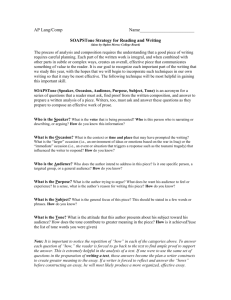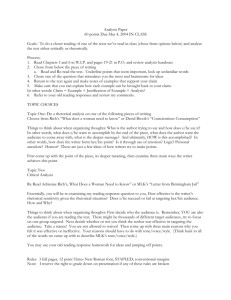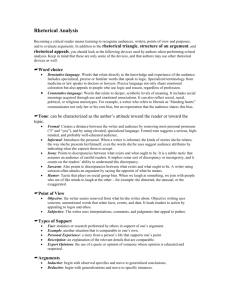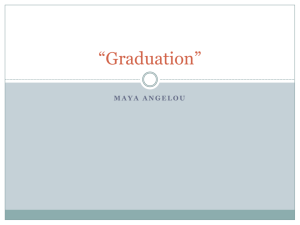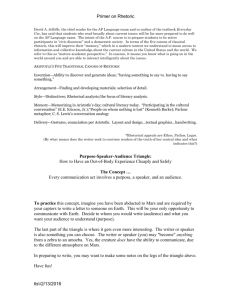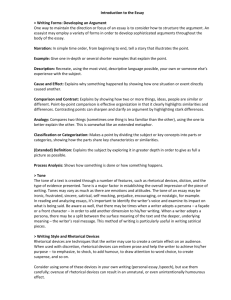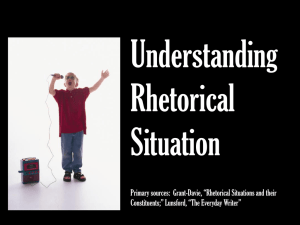Review of Rhetoric
advertisement
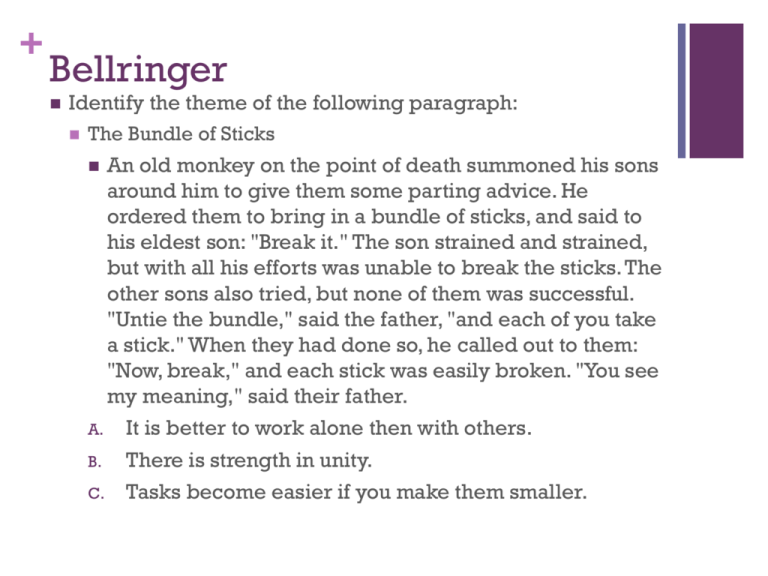
+ Bellringer Identify the theme of the following paragraph: The Bundle of Sticks An old monkey on the point of death summoned his sons around him to give them some parting advice. He ordered them to bring in a bundle of sticks, and said to his eldest son: "Break it." The son strained and strained, but with all his efforts was unable to break the sticks. The other sons also tried, but none of them was successful. "Untie the bundle," said the father, "and each of you take a stick." When they had done so, he called out to them: "Now, break," and each stick was easily broken. "You see my meaning," said their father. A. It is better to work alone then with others. B. There is strength in unity. C. Tasks become easier if you make them smaller. + Read Like a Writer AP ELA 11 August 28th, 2014 + Your Charge… Students will analyze various texts and genres, including informational, literary, and argumentative texts, multimedia texts, foundational US documents, and literary nonfiction. Students will analyze written arguments focusing on rehtorical elements, figurative language, and implied undertones. Students will analyze how the above items create tone, effect, and impact meaning. Students will successfully incorporate and evaluate multiple sources while avoiding plagiarism by including specific, relevant textual evidence in a their own written arguments. + How we do it… Work hard Study rhetorical skills & strategies Read actively Think critically Write like the stuff you’re reading about + ARISTOTLE….and the history of Rhetoric We define rhetoric, classically, as “the art of persuasion,” of knowing in any given case the available means of persuasion. Aristotle’s theory of rhetoric has proved useful to many students who are charged with making connections between audience, speaker/writer, and a text. + Rhetoric = Argument In class I will often use these words interchangeably. An argument is simply any piece that makes a claim. Quite literally everything can be viewed as an argument. PIE…yummy . And Now for some VOCAB! + SOAPStone S = Subject O = Occasion A = Audience P = Purpose S = Speaker Tone= yes + Subject In rhetoric, the topic addressed in a piece of writing. Example…what is the subject here? Some children seem to be motivated by food more than others. People wonder what causes these “reactive eaters.” While some argue they are born that way, our research shows that reactive eaters are created, not born, and it is because of parental influences on diet. + Occasion An aspect of context; the cause or reason for writing. Example…what is the occasion here? The childhood obesity epidemic is a hot-button issue in politics and the news. + Audience One’s listener or readership; those to whom a speech or piece of writing is addressed. Examples…who might the audience be? Readers of the NY Times' online Wellness Column– generally middle-aged mothers with children, or healthcare professionals in the nutrition field. + Purpose One’s intention or objective in a speech or piece of writing. Example…what is the purpose here? To inform the reader about current research being conducted about reactive eaters. To convince readers that children develop reactive eating behaviors as opposed to being born that way. To convince readers of a solution to the problem: providing better dietary choices as food for hungry kids. + Speaker A term used for author, speaker, or the person whose perspective (real or imagined) is being advanced in a speech or piece of writing. Example…who is the speaker for this? Tara Parker-Pope, author. She is an author of health books and a columnist for the NY Times. While nutritional science is not her specialty, she does write frequently on various health matters. Scholars in her field view her as a serious journalist and a valuable point of reference. + Tone The Speaker’s attitude toward the subject or audience. Example…what is the tone here? The tone the speaker takes in “The Lure of Forbidden Food” is detached and scientific. Only a few times does she lapse into a didactic tone. For the most part she remains objective. + Rhetorical Strategies Appeals- What Ethos Pathos Logos are they? + ETHOS A Greek term referring to the character of a person. Character of rhetorician is derived from their authority, reputation, and credibility. As Aristotle writes: “We believe good men more and more readily than others: this is true generally whatever the question is, and absolutely true where exact certainty is impossible and opinions are divided.” EXAMPLE: If the film gets two thumbs up, you’ll go see it because of whose thumbs are up. (Critic Roger Ebert) + PAHTOS: A Greek term that refers to suffering but has come to be associated with broader appeals to emotion. Emotional appeals utilize personal experiences or stories, emotionally charged language, images, and music, etc. In traditional academic writing, emotions tend to be dismissed in favor of reason: facts and logic. EXAMPLE: Countless commercials for humanitarian organizations such as UNICEF or the ASPCA. + LOGOS A Greek term that means “word”; an appeal to logic. This is the easiest appeal to spot and understand. A rhetorician can use factual information as a logical appeal, but logos can also refer to the structure of an argument. If an argument isn’t constructed logically, no one will care how solid your facts are. Logos can effect Ethos. In a world of pie charts and poll percentages, a rhetorician who uses facts and stats from a source with no credibility costs them theirs. EXAMPLE: The facts provided in the research from the article we read (Penn State). + Rhetorical Strategies Using the AP Language & Composition Textbook, define the following terms on the handout. (Use the glossary in the back). Allusion Analogy Close Reading Connotation Denotation Diction Inference Imagery Occasion Parallelism Repetition Theme + Syntax Syntax refers to how we arrange words to express thoughts. Note that a writer can choose innumerable ways to express the same thought via diction, detail, and arrangement: Example: I went to the store in the morning. In the morning, I went to the store. I drove to the store this morning. After sunrise, I went to the store. In the morning to the store I went. + Syntax From an AP standpoint, we want to pay careful attention to a writer’s syntax. A writer’s choice of word arrangement may contribute to the meaning. Consider the examples: I went to the store in the morning. To the store I went in the morning. In the morning to the store went I. The emphasis in each sentence shifts. The first emphasizes “I,” The second “store,” The third “morning.” In other words, the focus shifts from person to place to time. A writer can choose what element to emphasize by its placement in the sentence. The information is the same, but the emphasis differs— thereby potentially affecting the meaning in the context of the larger passage. + Syntax During close reading of AP level texts, you cannot analyze every sentence. Instead, look for patterns that appear throughout the selection. Ask yourself: Might this pattern in some way contribute to the point the author makes? Also, look for “standout sentences”—that is, a sentence whose pattern or arrangement is unlike anything around it. + Syntax The following terms and concepts pertaining to sentence structure are essential for reading closely and writing good analyses: Antithesis Ellipsis Inversion Juxtaposition Parallelism Repetition Rhetorical Question Rhetorical Fragment Provide a definition for each term in your notebooks. + Rhetorical Analysis Here are the questions that you need to ask in order to analyze an argumentative piece: Why did the author choose these strategies for the particular audience, occasion, and/or purpose? HOW do the rhetorical strategies help the author achieve his/her purpose? WHY does the author chose those strategies for that particular audience and for that particular occasion? + Write Like a Reader August 30, 2014 + RA Essay There are many ways to write an effective rhetorical analysis essay. You may find as you become more comfortable with analysis that you want to deviate from this format. That’s fine as long as you are still focusing on: 1. SOAPSTone 2. Appeals/Style 3. Questions + Intro paragraph- RA Essay The introductory paragraph to an analysis essay is usually brief. However, it must contain some essential information. Put SOAPS in your introduction and follow this format: FORMAT: 1. Speaker, Occasion, and Subject (Writer’s credentials), (writer’s first and last name), in his/her (type of text), (title of text), (strong verb – see list)(writer’s subject). Well-known essayist and writer, Joan Didion, in her essay, The Santa Ana, describes the dramatic mood altering effects of the Santa Ana winds on human behavior. 2. Purpose (Writer’s last name)’s purpose is to (what the writer does in the text). Didion’s purpose is to impress upon readers the idea that the winds themselves change the way people act and react. + Intro Paragraph – RA Essay 3. Audience He/she adopts a[n] (adjective describing the attitude/feeling conveyed by the writer) tone in order to (verb phrase describing what the writer wants readers to do/think) in his/her (intended audience). She creates a dramatic tone in order to convey to her readers the idea that the winds are sinister and their effects inescapable. + Example Identify the parts of SOAPSTone in your notebooks. Novelist, Amy Tan, in her narrative essay, “Fish Cheeks,” recounts an embarrassing Christmas Eve dinner when she was 14 years old. Tan’s purpose is to convey the idea that, at fourteen, she wasn’t able to recognize the love her mother had for her or the sacrifices she made. She adopts a sentimental tone in order to appeal to similar feelings and experiences in her adult readers. + Body paragraphs – RA Essay This is the analysis part! Include a detailed explanation of strategies used by the writer. When writing an analysis, it is crucial that you work chronologically through the text. You can discuss each paragraph (one at a time)or divide the text into sections (beginning, middle, end). – This is dependent on text length. Transition words to use to move through the text: Begins, opens, closes, contrasts, shifts to, juxtaposes, ends, moves to + Body Paragraphs Every analysis paragraph MUST: Identify the part of the text you are analyzing by using transition words and strong verbs to explain what is being said. Identify the strongest rhetorical strategies used in that particular section. This includes incorporating specific text examples (exact words from the text – see last page of this handout for proper format) into your own words. Do NOT try to discuss every strategy the writer uses; pick the strongest! Clearly and specifically explain how the rhetorical strategies are used to help the writer achieve his purpose and reach his audience. The above items must be woven together seamlessly into one sophisticated paragraph of the body of your analysis essay + Body Format The first sentence identifies which section of the text you are discussing and the main idea of that section. (Writer’s last name) (transition word) his/her (type of text) by (strong verb) that (main idea of this section of the text). The second sentence conveys the writer’s support for the main idea by identifying and providing a specific example for one rhetorical strategy used by the writer. [This sentence is repeated if you want to discuss more than one rhetorical strategy.] + Body Format The third sentence explains how the rhetorical strategies you discussed in the previous sentences help the writer achieve his purpose by using an in order to statement. He joins in this time of mourning in order to unify the nation and humbly admit that “we share this pain with all of the people of our country” (4). The fourth sentence identifies the effect of the writer’s use of these rhetorical strategies on the audience. + Example Reagan begins his tribute to the Challenger astronauts by acknowledging that the shuttle accident has appropriately postponed his planned State of the Union address and by expressing the depth of his and his wife’s personal grief. He appeals to the mournful emotions of the audience by admitting that he and Nancy are “pained to the core” (3), that today is rightfully a “day for mourning and remembering” (2-3), and that the accident is “truly a national loss” (4). He joins in this time of mourning in order to unify the nation and humbly admit that “we share this pain with all of the people of our country” (4). This outpouring of emotion from the president conveys a calming tone that reassures the Nation that their grief is both understandable and proper. + Conclusion The conclusion is probably the easiest part. Be brief. In onetwo sentences, simply remind your reader of the things you said in the introduction + Handouts KEEP IN YOUR BINDER FOR THE LOVE OF EVEYRTHING HOLY AND GOOD! + Reading Read Virginia Woolf “Professions for Women” on page 356. Answer the following questions in your notebooks. 1, 3, 5, - Questions for discussion 1, 2, 3, 5, 6, 10, 11, 12- Questions for Rhetoric and Style
